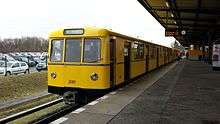BVG Class D
Class D is a type of electric multiple unit train used by Berlin U-Bahn.
After World War II the trains of the Berlin U-Bahn were worn out, making a new series of trains necessary. From 1957 on the new D type trains were delivered (also called Stahldora/Steel Dora). They were made of steel, making them very heavy. In 1965, the DL type was developed, which was constructed from lighter metals (also called Dora). This way, weight was reduced by 26%. Like in earlier types the seats were located along the sides of the train.
Class D

The D type cars have been introduced in various phases:
- D 55: The test vehicle (2000/2001), which is on the Line C II (Mehringdamm - Tempelhof)
- D 57: 26 trains (2002/2003 - 2052/2053), which is on the Line C I, during the opening of the line to Tegel (now known as U6).
- D 60: 30 trains (2054/2055 - 2112/2113), which is on the Line G (now known as U9, the line was built as an alternative line when the Berlin Wall is built).
- D 63: 36 trains (2114/2115 - 2184/2185), which is on the Line C I, during the opening of the line to Britz (now known as U7).
- D 65: 44 trains (2186/2187 - 2228/2229), which is on the Line C II, during the extension to Alt-Mariendorf.
On 1974 with the introduction of F type cars, the D 60 trains were redeployed to Line 6 and D 57 trains were redeployed to Line 8.
Because the BVB (the East Berlin public transport authority) needed more trains for their new route to Hönow, BVB bought 98 cars of this type from the BVG in several phases, which is older and the shelf lifespan is 30 years and needs replacement. BVB renumbered all trains that were sent to East Berlin into the numbering system with the class number "110":
- 1988: 2002/2003 to 2018/2019, 2022/2023 to 2052/2053 (when the U5 is extended to Elsterwader Platz), they were renumbered to 110 300 to 110 349.
- 1989: 2054/2055 to 2112/2113, with the exception of 2072/2073, 2076/2077 and 2100/2101 (when the U5 is extended to Hönow), they were renumbered to 110 350 to 110 401.
The first trains began revenue service on 110 326/327 (ex 2030/2031) and 110 306/307 (ex 2008/2009) on March 1988 via Alexanderplatz connecting tunnels. They were called DI in the east. Of course, they were painted in the East Berlin color scheme of ebony and yellow.
7 trains (110 386-110 397, also known as 2096 to 2099 and 2102 to 2109) all returned to BVG early on November 1990. After the merger of BVB with BVG in January 1992, these trains continued to deploy on the U5, U6, U7 and U8 until the retirement in 1998-99. The last trains of the 'D' type were retired in 1999, and they were sold to Pyongyang Metro, North Korea.

Class DL
The DL type cars have been introduced in various phases:
- DL65: 3 trains (2230/2231 - 2234/2235), which is on the Line H, during the extension to Mockernbrücke.
- DL68: 68 trains (2236/2237 - 2370/2371), which is on the Line 6, replacing B type cars.
- DL70: 30 trains (2372/2373 - 2430/2431), which is on the Line 7, during the extension to Rudow.
The DL trains were all deployed on Line 6 and 7 until 1992, and most of them were also deployed to Line U5 after the merger of BVB with BVG.
The last trains of this type were retired at the end of the year 2004. The traditional farewell run of this series was on 27 February 2005. No trains have been preserved in the DL series, and all were scrapped at Eberswalde.
Preservation
There are only two museum trains, 2000/2001 (Prototype) and 2020/2021. Due to insufficient number of trains as well as financing constraints, the BVG decided in 2016 to modernise these two units for service on the line U55 until the U5 extension opens in 2019. These trains were equipped with electronic destination displays, and to adapt with their modern safety requirements. Buttons will replace their handles on doors. Flashing lights and warning sounds have also been introduced to the trains to let passengers know whenever doors are closing or opening. Cameras will also be installed as part of security for customers and rail staff. The green seats will remain but it will be upholstered, while an adverts from the Cold War, World War II and Adolf Hitler is being planned to create a sense of nostalgia. The historic trains began running on 1 March 2017 for 23-day trial on U5 before moving to the U55.
The trains had outlasted London Underground A60 and A62 Stock that was withdrawn in 2012, as well as some of the oldest rolling stock of any metro system anywhere in the world such as R32 cars and La Brugeoise trains, Metropolitan Cammell trains and Siemens-Schuckert Orenstein & Koppel trains of the Buenos Aires Metro.